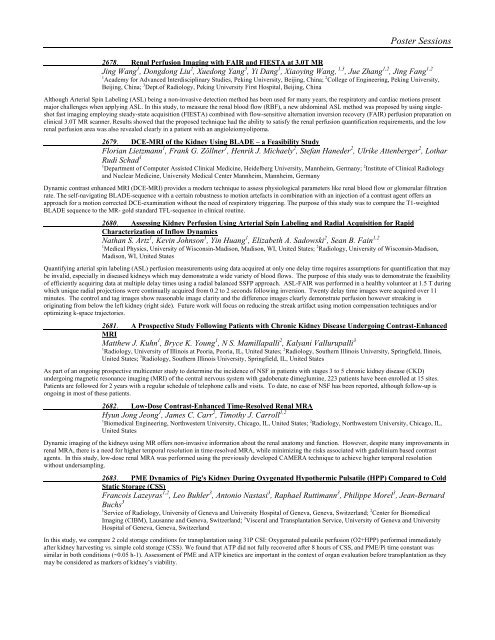TRADITIONAL POSTER - ismrm
TRADITIONAL POSTER - ismrm
TRADITIONAL POSTER - ismrm
You also want an ePaper? Increase the reach of your titles
YUMPU automatically turns print PDFs into web optimized ePapers that Google loves.
Poster Sessions<br />
2678. Renal Perfusion Imaging with FAIR and FIESTA at 3.0T MR<br />
Jing Wang 1 , Dongdong Liu 2 , Xuedong Yang 3 , Yi Dang 1 , Xiaoying Wang, 1,3 , Jue Zhang 1,2 , Jing Fang 1,2<br />
1 Academy for Advanced Interdisciplinary Studies, Peking University, Beijing, China; 2 College of Engineering, Peking University,<br />
Beijing, China; 3 Dept.of Radiology, Peking University First Hospital, Beijing, China<br />
Although Arterial Spin Labeling (ASL) being a non-invasive detection method has been used for many years, the respiratory and cardiac motions present<br />
major challenges when applying ASL. In this study, to measure the renal blood flow (RBF), a new abdominal ASL method was proposed by using singleshot<br />
fast imaging employing steady-state acquisition (FIESTA) combined with flow-sensitive alternation inversion recovery (FAIR) perfusion preparation on<br />
clinical 3.0T MR scanner. Results showed that the proposed technique had the ability to satisfy the renal perfusion quantification requirements, and the low<br />
renal perfusion area was also revealed clearly in a patient with an angioleiomyolipoma.<br />
2679. DCE-MRI of the Kidney Using BLADE – a Feasibility Study<br />
Florian Lietzmann 1 , Frank G. Zöllner 1 , Henrik J. Michaely 2 , Stefan Haneder 2 , Ulrike Attenberger 2 , Lothar<br />
Rudi Schad 1<br />
1 Department of Computer Assisted Clinical Medicine, Heidelberg University, Mannheim, Germany; 2 Institute of Clinical Radiology<br />
and Nuclear Medicine, University Medical Center Mannheim, Mannheim, Germany<br />
Dynamic contrast enhanced MRI (DCE-MRI) provides a modern technique to assess physiological parameters like renal blood flow or glomerular filtration<br />
rate. The self-navigating BLADE-sequence with a certain robustness to motion artefacts in combination with an injection of a contrast agent offers an<br />
approach for a motion corrected DCE-examination without the need of respiratory triggering. The purpose of this study was to compare the T1-weighted<br />
BLADE sequence to the MR- gold standard TFL-sequence in clinical routine.<br />
2680. Assessing Kidney Perfusion Using Arterial Spin Labeling and Radial Acquisition for Rapid<br />
Characterization of Inflow Dynamics<br />
Nathan S. Artz 1 , Kevin Johnson 1 , Yin Huang 1 , Elizabeth A. Sadowski 2 , Sean B. Fain 1,2<br />
1 Medical Physics, University of Wisconsin-Madison, Madison, WI, United States; 2 Radiology, University of Wisconsin-Madison,<br />
Madison, WI, United States<br />
Quantifying arterial spin labeling (ASL) perfusion measurements using data acquired at only one delay time requires assumptions for quantification that may<br />
be invalid, especially in diseased kidneys which may demonstrate a wide variety of blood flows. The purpose of this study was to demonstrate the feasibility<br />
of efficiently acquiring data at multiple delay times using a radial balanced SSFP approach. ASL-FAIR was performed in a healthy volunteer at 1.5 T during<br />
which unique radial projections were continually acquired from 0.2 to 2 seconds following inversion. Twenty delay time images were acquired over 11<br />
minutes. The control and tag images show reasonable image clarity and the difference images clearly demonstrate perfusion however streaking is<br />
originating from below the left kidney (right side). Future work will focus on reducing the streak artifact using motion compensation techniques and/or<br />
optimizing k-space trajectories.<br />
2681. A Prospective Study Following Patients with Chronic Kidney Disease Undergoing Contrast-Enhanced<br />
MRI<br />
Matthew J. Kuhn 1 , Bryce K. Young 1 , N S. Mamillapalli 2 , Kalyani Vallurupalli 3<br />
1 Radiology, University of Illinois at Peoria, Peoria, IL, United States; 2 Radiology, Southern Illinois University, Springfield, Ilinois,<br />
United States; 3 Radiology, Southern Illinois University, Springfield, IL, United States<br />
As part of an ongoing prospective multicenter study to determine the incidence of NSF in patients with stages 3 to 5 chronic kidney disease (CKD)<br />
undergoing magnetic resonance imaging (MRI) of the central nervous system with gadobenate dimeglumine, 223 patients have been enrolled at 15 sites.<br />
Patients are followed for 2 years with a regular schedule of telephone calls and visits. To date, no case of NSF has been reported, although follow-up is<br />
ongoing in most of these patients.<br />
2682. Low-Dose Contrast-Enhanced Time-Resolved Renal MRA<br />
Hyun Jong Jeong 1 , James C. Carr 2 , Timothy J. Carroll 1,2<br />
1 Biomedical Engineering, Northwestern University, Chicago, IL, United States; 2 Radiology, Northwestern University, Chicago, IL,<br />
United States<br />
Dynamic imaging of the kidneys using MR offers non-invasive information about the renal anatomy and function. However, despite many improvements in<br />
renal MRA, there is a need for higher temporal resolution in time-resolved MRA, while minimizing the risks associated with gadolinium based contrast<br />
agents. In this study, low-dose renal MRA was performed using the previously developed CAMERA technique to achieve higher temporal resolution<br />
without undersampling.<br />
2683. PME Dynamics of Pig's Kidney During Oxygenated Hypothermic Pulsatile (HPP) Compared to Cold<br />
Static Storage (CSS)<br />
Francois Lazeyras 1,2 , Leo Buhler 3 , Antonio Nastasi 3 , Raphael Ruttimann 3 , Philippe Morel 3 , Jean-Bernard<br />
Buchs 3<br />
1 Service of Radiology, University of Geneva and University Hospital of Geneva, Geneva, Switzerland; 2 Center for Biomedical<br />
Imaging (CIBM), Lausanne and Geneva, Switzerland; 3 Visceral and Transplantation Service, University of Geneva and University<br />
Hospital of Geneva, Geneva, Switzerland<br />
In this study, we compare 2 cold storage conditions for transplantation using 31P CSI: Oxygenated pulsatile perfusion (O2+HPP) performed immediately<br />
after kidney harvesting vs. simple cold storage (CSS). We found that ATP did not fully recovered after 8 hours of CSS, and PME/Pi time constant was<br />
similar in both conditions (~0.05 h-1). Assessment of PME and ATP kinetics are important in the context of organ evaluation before transplantation as they<br />
may be considered as markers of kidney’s viability.















